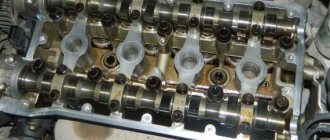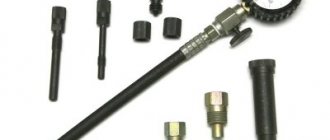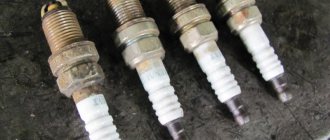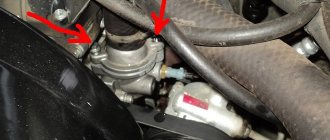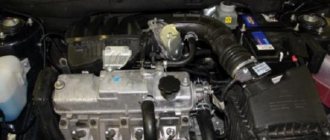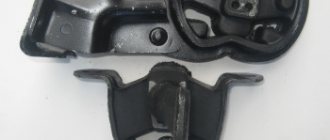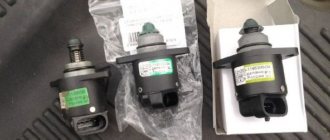Sealant selection criteria
To select the appropriate material for repairing the engine lubrication system, you need to consider the following:
- The sealing compound must be resistant to temperature changes, shock loads and vibration.
- Create strong and elastic adhesion to surfaces of complex textures (metal of varying densities).
- Be resistant to moisture, oil, lubricants and coolants.
- Have an operating temperature range from -60 to +300 ⁰С.
- The chemical composition is neutral to elements made of cast iron, aluminum, steel.
You should not buy cheap engine sump sealant from unknown manufacturers. The high-quality composition has factory packaging indicating the country and name of the manufacturer, instructions and recommendations for use.
It is better to purchase repair products from large auto stores or branded car dealerships.
Oil pan sealants differ in chemical components, temperature tolerances, constituent chemical elements, degree of flexibility of the seam formed, and level of operating loads. Main types of repair trains:
Silicone
The silicones included in the paste for repairing the engine lubrication system give it a high degree of adhesion, the ability to maintain properties at sharply changing temperatures, dielectric properties, and chemical inertness.
This explains the great demand for this type of sealant among service station mechanics and car enthusiasts. The components in the composition polymerize due to moisture from the environment and quickly form a solid, sealed seam.
The silicone composition hardens within 8–12 minutes. Therefore, you need to connect the parts quickly enough so that it does not have time to set.
Advantages of silicone composition:
- Large surface area for sealing. The hole size can be up to 6 mm.
- Creates a flexible seam that can withstand deformation and forced loads.
- Gives hydrophobicity to the seam.
- Long service life.
- Hardening of the surfaces to be joined within 20 minutes.
Anaerobic
These clamps appeared on sale 4-5 years ago. An anaerobic engine sump sealant requires the absence of oxygen to be effective. To do this, the composition is applied to the adhesive surfaces, which are then compressed with force to squeeze out the air between them. Coupling occurs within 25–35 minutes.
If the application surface is uneven, oxygen may remain between the parts. This will prevent the sealant from completely curing.
Features of anaerobic sealant:
- Creates a flexible seam.
- The temperature when working with sealant for the engine oil system is not lower than 15 ⁰С.
- The size of the holes being machined is 0.1 mm.
- There is no need to rush when applying to parts, since the sealant retains its liquid base state when exposed to air. This is an advantage for working with large diameter parts.
Heat resistant
Since the engine is a source of elevated temperatures, the sealant for repairing its components must be heat-resistant.
These compositions have a working temperature tolerance of up to 380 ⁰C.
To work with elements of the bottom of the engine oil flask, materials with thermal stability indicators of up to 190 ⁰C are suitable.
Engine sump sealant: types and properties
Many world-famous manufacturers have long opted for polymer compounds for sealing elements of a car’s lubrication system, pushing the once traditional gaskets a step back.
In terms of their performance properties, liquid sealants are far ahead of classic gaskets. They harden easily if certain conditions are met, determined by the chemical formula of the product.
Engine sump sealants began to be produced not so long ago, but have already successfully conquered their niche, proving in practice their beneficial properties and effectiveness of use. The main purpose of such technical fluids is not only to replace failed gasket sets, but to prevent oil leakage through the valve cover of the oil pan housing.
Kinds
Today, the market for automotive consumables and related materials offers a fairly large selection of sealants. They may differ from each other in color, temperature, constituent chemical elements, degree of elasticity, level of resistance and many other performance characteristics. Basic qualifications divide sealants into three main types.
Silicone
The most popular, both among professional craftsmen and novice car enthusiasts. It is very convenient to work with, as it contains natural ingredients. They quickly take on a solid form upon contact with moisture present in the air.
About ten minutes is enough for the required volume of liquid to accumulate. This time is enough to secure the necessary elements. But if you are working with large parts, then you should be more careful when working, because the liquid sealant can harden even before the two units are fixed.
If this does happen, it is recommended to remove any remaining hardened sealant from the surface before attempting to connect the parts a second time.
The main advantages of silicone-based sealant are:
- indicator of the maximum thickness of the gap that is planned to be filled with a sealed compound - up to 6 mm;
- withstands fairly high pressure, which is very important for modern power structures;
- the formation of an elastic seam with long-term performance characteristics, which means that oil will not flow through the cylinder head (cylinder head), crankcase gap and/or engine sections for a long period
When using silicone sealant, you must remember that it works effectively only on surfaces that have been previously cleaned of dirt and oil.
Anaerobic
It is more modern than the previous tool. While silicone-based sealants require moisture to harden, anaerobic sealants require the absence of oxygen. To fasten two parts, it is necessary to apply the composition to a previously cleaned surface. Then connect the surfaces as tightly as possible, thereby stopping the access of air so that the sealant begins to harden.
When working, extreme care is required, because if even a small gap is not eliminated in any place, thereby not closing the oxygen flow, the anaerobic sealant will remain in liquid form.
Despite the fact that only the absence of oxygen is necessary for the sealant to harden, you should not delay working with it. If the composition is applied in advance to the surfaces to be bonded, then dust or dirt may naturally get on them, which will significantly deteriorate the quality of fixation.
Therefore, it is recommended to apply liquid sealant immediately before gluing two surfaces. If everything is done efficiently, the resulting seam will have a high degree of elasticity, which is an undoubted advantage for further use.
However, anaerobic sealants also have a number of disadvantages. The main ones include:
- small thickness of the cavity, only 0.5 mm compared to 6 mm of silicone sealant;
- under conditions of high pressure, the composition may be disrupted;
- if the composition is applied unevenly, part of it may remain in its original liquid state
Heat resistant
When working with a car engine, it is more advisable to use sealants that have a high temperature index. They can withstand up to 3750C. In the case where you plan to work with components and parts of the engine compartment, then it is possible to use a sealant with slightly low temperature indicators, for example, only 1700C.
When choosing a sealant from a particular manufacturer, it is recommended to carefully study the attached instructions. Some formulations are suitable for a certain make of car. To date, there are no serious problems in the availability of sealed compounds. You can buy them at a car store, service center, or order delivery from a catalog on various online resources that correspond to the topic.
You should give your preference to well-known brands that have been proven over the years. Of course, they are much more expensive than their Chinese counterpart. However, for the money spent you can be guaranteed to get a good quality sealant with high performance characteristics.
In order to insure yourself against purchasing a counterfeit at the price of a branded product, when purchasing, you should pay close attention to the presence of a hologram, barcode and other control markers on the packaging, which real manufacturers must apply to the packaging.
avtodvigateli.com
Review of common sealants
Today, most automakers also produce related components and materials for repairing their car brands. Therefore, you can purchase an original sealant personalized for your car brand.
If this is not possible, then analogues with similar properties will do.
Motor heat-resistant repair compound GOETZE (gray) made in Germany, Liqui Moli, Hi Gear and anaerobic Loctite have proven themselves to be quite good. The main advantages of these sealing pastes are:
- high adhesion strength;
- heat resistance (from -55 °C to +230 °C);
- fast curing;
- application using an auto-dispenser;
- no finishing of parts required; permissible surface roughness 8–40 µm (Ra).
The price of these products for the oil pan is 750–900 rubles.
Elring and REINZ (Germany) for the engine cost 350–500 rubles. They are not inferior in many respects to the previous ones. The only difference is that it takes longer to cure.
- High seam strength.
- Immunity to chemicals.
- Operating temperature range from -50 to + 200 ⁰С.
- Resistant to sudden temperature changes.
Abro sealant 5 years ago was a favorite among auto mechanics. Has high quality indicators. But over the past 3-4 years, many fakes have appeared. Therefore, buying Abro can be compared to a lottery. Its cost is 150–250 rubles.
How to choose
Before choosing, read the information on the package; a quality engine sealant satisfies the following needs.
- Use on materials such as steel, aluminum and cast iron.
- Resistance to temperature changes, vibrations and loads.
- Operating temperature range from -60 to + 300 ⁰С.
- Moisture resistance, immunity to oils and other motor fluids.
- Creation of a durable and elastic gasket.
Cheap sealant is not always the joy of saving money. Usually these are still negative emotions from work that needs to be redone. Such compounds (most of them are cheap) do not have a clear description or recommendations. It is difficult to determine the country of production on them. Don't buy questionable products.
Not all oil pan sealants are created equal. They are divided into several groups having different components in their composition. They also need to be used in different ways.
Anaerobic
These sealants are new but are a popular product for repair purposes. Adhesion and hardening occurs when two parts are compressed for half an hour. Read the manufacturer's packaging for exact instructions.
Oxygen has an effect on the mixture due to which it can remain soft, as if it had just been squeezed out of the package. This way you don’t have to rush to press the parts, but carefully spread the required layer around the entire perimeter.
The maximum layer applied by anaerobic products is up to 5 mm. In this case, the surface must be flat. When the sealant is smeared on the part, dust, sand and other small debris may “fall” onto it. In this regard, it is recommended not to tighten the pressing of parts. The more debris that wet sealant collects, the worse its cutting properties will be.
Silicone
Perhaps the most popular sealant for engine repair. The mixture can be applied in a layer of up to 6 mm. The resulting gasket seam remains elastic for a long time. Designed to work with high pressure.
Before use, the surface must be thoroughly prepared (cleaned and degreased). The silicone mixture for the crankcase (compared to the anaerobic composition) hardens due to air humidity, so do not delay pressing the parts. Read the instructions on the packaging, it usually indicates the exact time that you need to wait and then press the parts firmly.
Repair
This type of sealant is classified as an express product that does not replace the need for repair work, but only “delays” it a little. As a rule, they are sold in liquid form. The engine filler neck (where engine oil is poured) is filled with oil, after which the repair sealant itself finds oil leaks and successfully stops them.
It will be useful: Hydro or electric power steering, which is better?
You can carry the repair product with you in reserve. If trouble happens on the road, he can be of great help.
Varieties
Products for sealing cylinder head covers and oil pans have a liquid consistency. The main function of the valve cover gasket sealant is to ensure complete absence of lubricant leakage from the engine cylinder head.
To choose the right sealing compound, you need to consider what components the engine sealant is made of and whether the substance has sufficient heat resistance. High-quality preparations for the prevention and repair of internal combustion engines are anaerobes and silicones.
Anaerobic sealant
The main advantage of using anaerobic engine sealant is the long-term activity of the components in the presence of air and rapid hardening in the absence of oxygen. This allows a repairman or a novice motorist to correct the mating of the parts being processed. In simple words, if you were unable to apply the cylinder head sealant correctly the first time, you can slowly align the contacting parts for a tight seal. Advantages of Anaerobes for Valve Caps:
- Solidification rate in air and airless space.
- Obtaining a uniform sealing film on parts.
- Wide operating temperature range, thermal stability.
What to use
Automotive manufacturers produce a wide range of sealants. Substances differ in composition and rate of hardening. Which sealant to place the engine sump on is chosen depending on the purpose, versatility and quality of the product.
"Stop-flow"
Sealants of this category are intended for engine lubrication systems; they are poured directly into the engine. The composition does not allow oils to leak out of the engine. One of the most popular products is Hi-Gear 9041 (or 9043) Engine Sealant. Does not come into contact with an aggressive oil environment, restores the elasticity of oil seals and seals, and is suitable for preventive purposes. Hi-Gear engine oil system sealant is compatible with different types of motor oils, the scope of application is gasoline and diesel internal combustion engines.
Metal-ceramic sealant eliminates antifreeze leakage through the cylinder head gasket. You can repair aluminum and cast iron cylinder heads so as not to use welding. It withstands vibrations, shocks, deformations, high temperatures and pressure, and is in normal contact with engine oil and coolant.
Loctite 574
Loctite cylinder head sealant is produced by the famous brand Henkel. It is an anaerobic flange compound that hardens at temperatures between +15 and -25°C. Loctite 574 is used to fix metal surfaces, but access to oxygen must be prevented for complete polymerization of the substance. It is best used for hermetically sealing parts with a minimum technological gap, tightly pulled together.
Dow Corning Q3-1566
The highest quality and most effective American-made product. It is the best sealant for engines, has impeccable heat resistance characteristics - from -70 to +345°C. Scope of application: cylinder head, transmissions, water pumps, manifolds.
The product is resistant to motor oils and does not withstand the effects of antifreeze, water, or lubricants. It has good resistance to vibrations, shocks, deformations, and overheating (but you should not “boil” the engine). The product can be used to prevent internal combustion engine depressurization.
ABRO 11-AB
A classic example of good quality at an affordable price. Red (ABRO 11-AB universal engine sealant) - it can be used for almost all power units and components of the car, as an effective sealant. Main advantages:
- The maximum temperature resistance limit is up to +343°C.
- Waterproof, neutral to aggressive environments.
- Good resistance to mechanical stress.
ABRO 11-AB allows you to form a fairly strong elastic layer on the treated surface that can withstand any load.
It will be useful: How to stud tires with your own hands?
FÖRCH K157
The FÖRCH K157, K158 and K161 series of motor anaerobes have good characteristics. The substances work effectively under conditions of high temperature extremes and high pressure, when the engine experiences extreme loads. Areas of use: motor flanges, threaded connections.
Among the advantages of FÖRCH sealants are elasticity, adhesion and sealing strength, and chemical resistance. But for the composition to completely harden, it requires exposure to high temperatures from +80 to +100°C. Use strictly for its intended purpose, does not replace the gasket between the cylinder block and the cylinder head.
The brand's silicone sealants, K165-167, have good properties for sealing the engine oil pan. The main characteristics are good adhesion and elasticity of the coating.
Victor Reinz
Two main compositions are popular - REINZOPLAST (blue) and REINZOSIL (gray). The characteristics of the substances are almost identical, but for internal combustion engines Reinzoplast is preferable:
- Neutral when reacting with oils, antifreeze, fuels and lubricants, water.
- Retains properties even with sudden temperature changes from -50 to +250°C.
- Short-term withstands extreme exposure to +300°C.
Victor Reinz sealant is a universal sealant for the engine pan, with a high hardening speed (10-15 minutes). It is enough to apply the composition to a previously prepared surface, wait the prescribed time, and then install the gasket. After half an hour, you can start the engine.
Elring
The manufacturing company produces effective and durable motor sealants Dirko HT and S Profi Press HT with similar properties. Perfectly withstands aggressive influences of oils, fuels and lubricants, water, antifreeze. Particularly resistant to mechanical and stress and strong vibration, can withstand temperatures ranging from -50°C to +220 +250°C, for a short time - up to +300 degrees.
The manufacturer’s line includes another sealant, Dirko Spezial-Silikon, specifically designed for treating automotive oil pans and crankcases. Works well with surfaces subject to strong vibrations. It takes 5-10 minutes for the composition to harden.
Table 1 shows sealants that are also suitable for sealing internal combustion engine parts and their main advantages
Table 1. Engine sealants
Product nameTypeFeaturesAdvantagesPermatex Anaerobic Gasket MakerAnaerobicAluminum surface treatmentVibration resistance, elasticityCYCLO HI-Temp C-952SiliconeMetal partsStrength and reliability of connectionCuril K2, Curil TSiliconeEngine crankcaseHigh temperature resistanceMANNOL 9914 Gasket maker REDSiliconeCylinder headNeutral resistant to aggressive environmentsSoudalPolyurethane Engine oil pan, flangesFast hardening time in its group of productsHylomar MPolyurethaneUniversal applicationResistance to technical liquids
Packaging and equipment
For convenient use and storage, sealants are packaged in small tubes. The packaging ensures long-term preservation of the valve cover sealant. Most manufacturers produce products in compact tubes, up to one hundred grams. To make it convenient to apply the sealant to the oil pan, the tubes are equipped with caps with dispensers, which has undeniable advantages:
- Fixed amount of composition.
- Uniform distribution on parts.
- Preservation of qualities and properties for a long time.
To use the gasket sealant again, it is enough to remove some of the dried product from the dispenser with a sharp, thin object before repairing the engine. Professional compounds for service stations and repair shops are produced in bulk packaging, and the products are applied with a pistol.
Rules for connecting parts
To repair an engine with liquid sealants, it is not enough to find out which sealant is best for the engine - you need to apply the substance correctly. This will reliably seal the engine. How to correctly change the sealant of the oil pan or cylinder head cover:
- Surface preparation – clean from carbon deposits, rust, oils and dirt.
- Remove worn seals, carefully remove so as not to leave scratches.
- Degrease surfaces with solvent, white spirit, purified gasoline, and dry.
- Apply a layer of sealing compound, removing the cap, to one of the parts, distribute the layer applied to the valve cover.
- It is necessary to maintain the thickness of the layer and make the coating uniform.
- The silicone should be allowed to “set” for about 15 minutes, and then the parts should be pressed tightly.
- If you use an anaerobic compound to replace the oil pan sealant, you can fasten the parts at any time.
The final tightening of the bolts in the case of applying silicone is carried out half an hour after the surfaces have been pressed and not fully tightened with bolts.
Important: Over-tightening the fixing bolts can squeeze out the applied compound and make the connection leak. You can operate the motor after 0.5-12 hours.
